 |
Лаборатория СУДОМОДЕЛИЗМА |
 |
|
Модели-копии
|
VICKERS VEDETTE CORVETTE MODEL
|
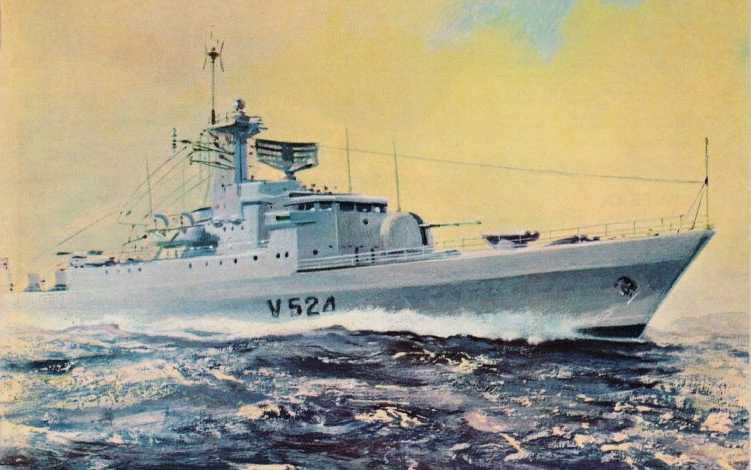
Your free Christmas plan — an attractive warship in the modern
style. Drawing and illustrations courtesy of Vickers Ltd., Barrow.
Full Size Printed Plan on a SHEET 34”x 24” (86,3 x 61.0 мм).
Scale 1:96
Length 31” (78,7 мм)
Beam 33/4" (9,5 мм)
Power electric 3 v
Twin drive
THE MODEL
A hull shape, evolved after extensive tank tests, is not
something that is just handed out - most shipbuilders
produce 'spoof' lines that give the general appearance
without giving away all their costly research. The hull shape
for this model has been evolved from the profile and main
deck plans (kindly provided by Vickers) plus Vickers
artists' impressions and the photograph of a publicity
model reproduced here; it may thus be perhaps liner in the
forward lower walerlines, or have too much/too little flare
or some other slight error of estimation. It should look like
the Vedette, however, which is really all that can be
expected for a modern ship design, especially one which has
not been built.
In the same way, there are minor discrepancies between
the various sketches etc. produced by Vickers, an obvious
example being the ladder up the mast, which is not shown at
all, shown on the foreside, or shown on the afterside. We
have interpreted such little details according to the main
drawing supplied to us, or where this is silent, as seems
logical.
Displacement on a narrow hull of the length of our plan
is limited - only just over 2lbs - but this is an entirely
feasible weight for the model. It is essential, however, to
keep the above-water structure as light as possible and
stow the weighty items as low as possible in order to achieve
stability. A body plan is included for those who fancy
building a bigger version; any photographer can blow this
up to desired size. A x 11/2 version, around 4ft long, would
weigh about 7lbs. Some builders making to the size drawn
may wish to introduce, say, an additional 1/8in lamination
beneath each of the three 1/2in planks shown, to give a 3/8in
increase in draught and another 10-12ozs, displacement.
Any 'spare' displacement could be used up on flotation
tests by recessing a piece of sheet lead in the underside of
the hull, to the advantage of stability.
Construction is, it is hoped, fairly self-evident. Cut and
assemble accurately the three 1/2in planks forming the hull
base. When dry the corners can be carved off the inside to
reduce the amount of later internal work, then the bulkheads
and other frame parts added and the skin completed.
Note that this is ply aft of station 5, but it is easier to plank
with balsa forward of this point.
The exterior can now be carved and sanded and any
further interior surplus material removed. To hollow the
base completely would require a slightly different technique;
the base planks would need to be shaped on the
outside to within a stage or so of final sanding, the interior
hollowed, and the base then set in a stand to receive the
bulkheads etc., and skin. A few grammes could be saved by
then cutting away redundant areas of bulkhead and the
superfluous corners of fillet strips before decking; it should
easily be possible to get the hull weight at this stage down to
under 8ozs.
Some builders will be quite happy to fit a single central
propeller, direct driving from an Orbit 405, Monoperin, or
similar motor, which would be light (about 31/2ozs, including
motor, with an aluminium prop tube) and would give a fast
turn of speed. Using twin shafts would increase this to
perhaps 5ozs (with pulley drive) or around 6ozs with a
lightweight gearbox. The latter systems would not be
likely to give increased speed, assuming the same motor,
but could possibly give a slightly longer battery life. With a
single prop it would be desirable to have a single centrally
mounted rudder, since the prop-wash needs to strike the
rudder to decrease turn radius; it may also be desirable to
increase the rudder chord (width) to get a tighter turn.
A 3 volt supply would be quite sufficient for good speed
and as usual the biggest possible battery should be used. As
a guide, a No. 800 twin-cell 3v 'bicycle front lamp' battery
weighs about 8ozs and should give reasonable running
time, but it might be better to use several smaller batteries
wired to provide a 3v output, on the basis that they could fit
lower in the hull. Those using rechargeable cells - NCC
160s would be an excellent choice - need only check the
weight of the completed model and add cells to bring it to
its required waterline.
The superstructure is a slightly complex shape and it
might well be helpful to make it up in thin card as a dummy
run before cutting it out in 8mm ply (or 1/16in balsa if
preferred). Temporarily fit deck 01 and work aft from the
enclosed bridge, making in effect a series of boxes. Cut
away all internal surplus material to reduce weight. Note
that a break is suggested through the open bridge, enabling
a large rectangular hatch to be provided, needing only the
long fore and aft aerials unhooked to detach most of the
superstructure.
Fittings and details again need to be kept very light.
Things like the box launchers for missiles, at the stern, the
rocket launchers between the breakwaters, and the
torpedo tubes aft of the boats can all be hollow, using
sheet balsa, rolled paper tubes, etc., while the Mk 8 and
Bofors gun turrets and boats can be soft balsa. Unless the
model will be for showcase use only, the use of metal in the
details is best confined to stainiess c/1 wire for whip aerials,
a few wire items such as yards and braces, stanchions and
ladders, and of course chain on the forecastle. A lot of other
bits and pieces can conveniently be made from plastic
oddments, card, dowel, etc., bearing in mind that permissible
weight is limited and too much weight aloft will cause
the model to run with a permanent list.
With all the emphasis on weight, it may be a surprise to
suggest radio control, but it is quite possible to have rudder
and motor control for about 8ozs, using one of the light
1+1 sets. Remember that quite a few plastic warship kits
smaller than this model have been successfully motorised
and fitted with R/C, and polystyrene is a heavier material
than timber.
When we published drawings for a similar-sized corvette
six years ago, hundreds were successfully built, but there
were two builders who informed us that they had run into
difficulty through coming out top-heavy. The only answer,
once the model is built is to lake a leaf out of the scale
square-rig book and add a false 'keel'. This could be a
shape cut from say 24x2in block balsa,streamlined in plan
form, with sheet lead fastened to its underside, the whole
baing secured beneath the model's hull. It would not be
noticeable with the model afloat, and could be removable
tor display purposes. At least it would mean that a too
heavily-built model could be run, though with reasonable
care in building no such emergency measure shoud be necessary.
Your free Christmas plan —
an attractive warship in the modern
style. Drawing and illustrations
courtesy of Vickers Ltd., Barrow
|
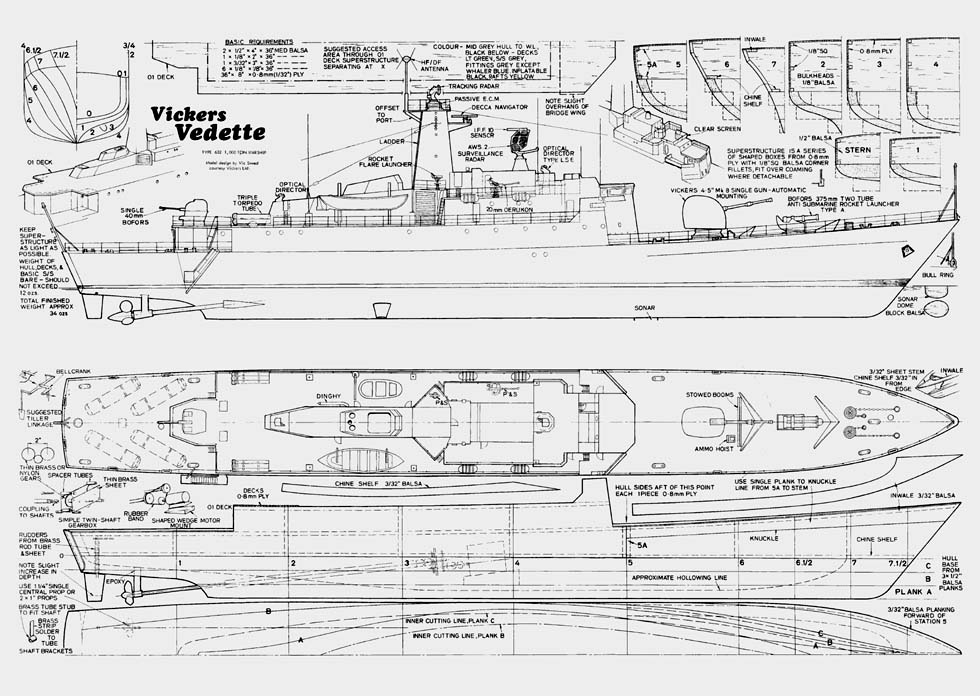
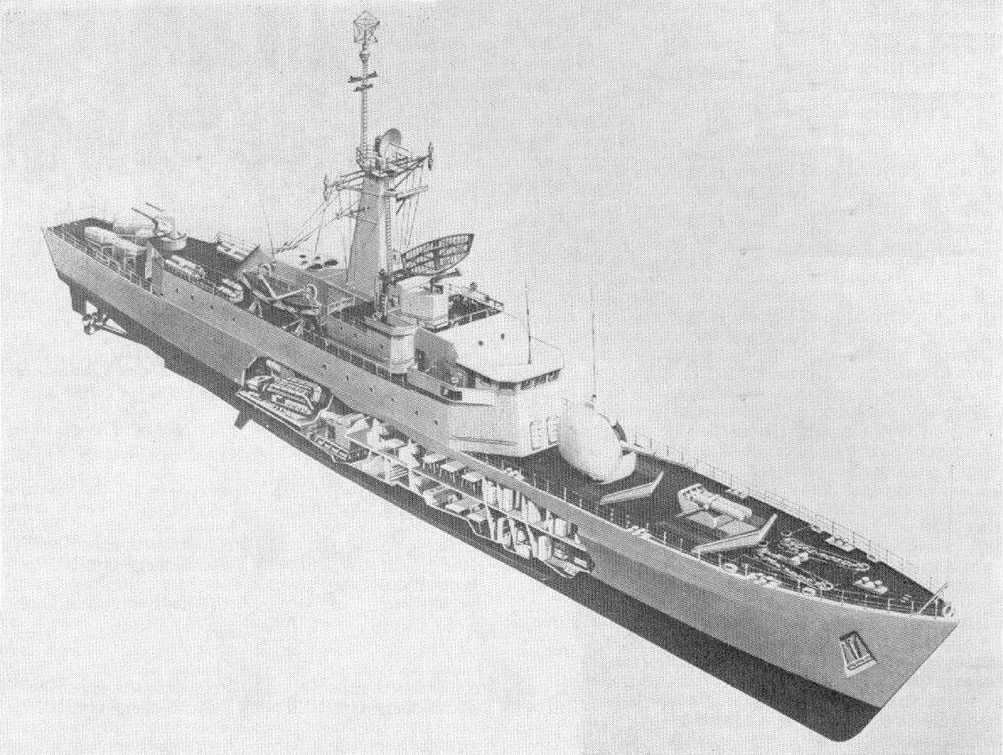
 Model of the Vedette professionally made for Vickers Ltd.
gives an excellent idea of the attractive appearance,
if a shade heavy on the guard-rails. Differences
from sketch opposite include ladder on
mast, surround for exhaust outlets aft of
mast, radar details, and engine room air intakes.
Model of the Vedette professionally made for Vickers Ltd.
gives an excellent idea of the attractive appearance,
if a shade heavy on the guard-rails. Differences
from sketch opposite include ladder on
mast, surround for exhaust outlets aft of
mast, radar details, and engine room air intakes.
|
VICKERS VEDETTE MULTI-PURPOSE CORVETTE PROJECT
IN an ideal world it would be possible for a navy to have a
shipbuilder of experience build the ideal warship - a
vessel capable of fulfilling a multiplicity of roles, packing a
powerful punch in the way of weaponry, and so reliant on
advanced technology that only a minimal number of men
would be required to operate the ship efficiently and
effectively. The cost would be such as to placate any
Treasury, and the Naval Staff would be satisfied that their
dreams had come true.
The ideal, alas, does not exist. Naval staffs and shipbuilders
exist and work in a world where the task has to be
identified by one and the tool with which to perform that
task has to be designed by the other. Looking over their
shoulders, as it were, is the Chancellor of the Exchequer
and it is he, as well as the Commanders in Chief, who has
to be convinced that what is eventually produced will give
full value for money in efficiency, effectiveness, acceptable
maintenance costs and equally acceptable running costs.
That might well explain why, today, there is so much
emphasis on a multiple role for a warship and why so much
effort is concentrated on producing designs which will have
a virtually universal appeal.
The task is daunting but, so far, the British appear to
have done quite well in facing up to it. The British Ministry
of Defence, for instance, has produced designs such as
those for the Launder class frigates and the Type 42 and 21
destroyers. They have also conceived the Command
Cruiser as a ship which can perform at least three tasks, and
while their ideas about craft as large as the Type 81 frigates
such as HMS Bristol might have been proved by time and
money to be less attractive than they were, no one can
suggest that there is a paucity of ideas.
There is always an export potential in any successful
British design; hence the attractiveness of the Leander to
India and the interest by Argentina in the Type 42, an
interest that has crystallized into orders for two ships. Not
quite so widely publicised was the joint success of Vosper
and Vickers in producing the 36 knot gas turbine-driven
Mark V destroyer, four of which were sold to the Imperial
Iranian Navy. Now, another promising new design has
emerged upon the scene ... the Vickers Vedette.
More than ten years have passed since Vickers first
foresaw the need for a small powerful ocean-going warship
which would fill the gap which then existed - and still does
in many navies - between the coastal and inshore craft on
the one hand and the much larger ocean-going frigates and
destroyers on the other. The Mk V Destroyer venture was a
step in this direction but for a variety of reasons the
development of the design resulted in a ship rather larger
than had first been envisaged. The gap remained and by
this time the incentive to fill it had been strengthened by
influences which were much more relevant than the mere
existence of the gap.
Until the mid 1960s warship costs had been rising slowly
in step with the general low level of inflation of about 6%
per annum. Then costs began to escalate at a much higher
rate until today they have virtually 'taken off' - 50%
increase in 1974 alone and no sign of any levelling off. There
are few, if any, defence budgets which can absorb continued
cost increases of these proportions and some form
of exacting reappraisal of the naval role and of the types of
ship necessary to fulfil it is almost certainly being conducted
at this moment by many naval staffs.
It is fairly obvious that one way of restricting unit costs
is to restrict the size of the unit but is equally obvious that
there must be some lower limit of size if the outcome is to be
a warship with realistic capabilities which will enable it to
undertake most of the duties of the larger ships which it is
to replace.
To resolve this problem Vickers approached it from two
directions. Their analysis of warship costs showed that if
the displacement was reduced much below 1000 tons the
specific cost, in terms of cost per ton of displacement,
increased sharply. Above this displacement the specific
cost rose slightly and then levelled off. A displacement of
1000 tons therefore seemed to offer the best value for money
and it remained to be seen whether the prime requirement,
a credible ocean-going capability, could be achieved on this
displacement. An entirely new hull form was developed and
thoroughly tested in the Vickers ship model tank at St
Albans. The results exceeded all expectations - the performance
in certain respects being better than that of a
Leander class frigate.
In all this activity time had been on the side of Vickers,
for recent developments in weaponry and the associated
electronics had by then made feasible the whole concept of
a modern fighting ship within the size limits of the hard
worked wartime Hunt class destroyers of the Royal Navy.
The Mark 8 gun, for instance, weighed something like
28 tons and required two men against the 50-ton gun and
20 men of 20 years previously. A powerful and very
modern weapon if it was practicable, and, as the design
developed, it became evident that the new ship could even
be given the capability of operating a Lynx helicopter. That
particular point is now being pursued.
By coincidence, a type name had been chosen before the
design studies were seriously under way, and, in the Vickers
tradition, the type had the initial letter V - Vedette, a
French word meaning lookout or sentry. It has turned out
to be a most appropriate choice, for the Vickers Vedette,
now at the stage where it can be offered to the world, will
be able to meet tactical and strategic requirements beyond
the capabilities of small corvettes or patrol craft. These can
be readily seen as the defence of shipping, the escort of
naval task forces, the peacetime role of ocean policeman,
and the reconnaisance and surveillance that are clearly the
duties of the vedette.
One of Vedette's principal strong points is that it
represents a huge saving in manpower - i.e. a crew of 75 all
told with about 20 bunks for training, against about 245 for
Leander. The importance of this is obvious when one
considers that the gross cost of the crew - including recruitment,
training and pay - accounts for 40-55% of total
life cycle costs in Royal Navy ships.
The designed tonnage of the current versions has slightly
exceeded the planned 1,000, but already Vickers are able to
offer a ship with a displacement of about 1,100 tons, and
alternative propulsion systems. With CODOG arrangement
of Paxman diesels and a Rolls-Royce Olympus gas
turbine developing a maximum 25,000 shp the speed is 32
knots and the range 6,440 kilometres at 16 knots. Given
two diesel engines and a total maximum power of 8,300
shp, the top speed is about 24 knots and the range 4,830
kilometres at 16 knots.
There are now four basic versions of the same design and
the possibility of others being developed, the armament
varying slightly according to basic purpose - see separate
lables. Air surveillance, tracking, and navigational radar,
plus sonar are all included in each outfit.
Pricewise, Vickers see their ship having total life-cycle
costs of about 45% of comparable figures for a typical
frigate. Britain, for instance, might be persuaded to
consider the usefulness of the Vedette in a surveillance role
for offshore oil rigs, particularly as Vickers, rather expert in
being able to assess through-life costs, consider that their
Vedette will be able to spend half her operational life at sea.
Better still, from the point of view of any Treasury, the
total cost per day of operation for the Vedette will be about
35% of the equivalent figure for a frigate of the Leander
type. Vickers have made no secret of the fact that the background
of the Vedette design is essentially one of simple
economics. That should not surprise anybody, but it
probably explains why a Vedette hull, with a walerline
length of 250 feet and a beam of 32 feet, will be of welded
mild steel construction. It will be simpler, cheaper and
more robust than is common in warships, and the use of
widely available commercial plates and sections will
simplify maintenance and repair. General layout is conventional
but there is emphasis on functional grouping and
good communication. All operational, working and living
spaces will be air conditioned and the ship's habitabilily
generally will be better than current British Ministry of
Defence standards.
One other rather interesting point is that aluminium
alloy will be employed extensively in the construction of the
superstructure, a building technique employed with
considerable success in liners like the Oriana and Queen
Elizabeth 2. That has helped Vickers keep within their selfimposed
limits and it might also be a help in selling what is
clearly much more than an interesting exercise in design. In
Vedette. Vickers could well have a winner for both the
home and export markets.
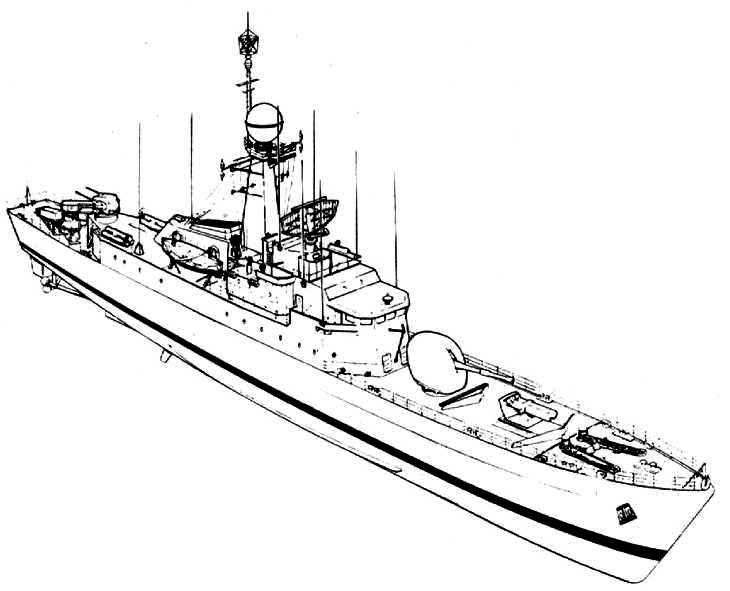
 Four variants of the Vedette are shown below, and details are as follows
Four variants of the Vedette are shown below, and details are as follows
Type 531 General Purpose, twin screw diesel, 1 113mm cingle gun, 1 35mm twin,
2 20mm single, 2 surface-to-surface missiles, 2 triple A/S torpedo tubes,
1 375mm twin A/S rocket launcher, 2 decoy launchers.
Type 634 General Purpose, CODOG, 1 120mm single gun, 1 40mm twin, 2 30mm twin,
8 s-to-s missiles, 2 triple A/S torpedo tubes, 1 375mm launcher.
Type 643 Anti-submarine, CODOG, 1 113mm single gun, 2 30mm twin,
1 A/S helicopter, 2 triple tubes, 1 375mm launcher.
Type 652 Anti-aircraft, 1 76mm single gun, 1 40mm twin, 2 20mm single,
1 surface-to-air missile system, 8 s-to-s missiles, 2 triple tubes, 2 decay launchers.
VELETTE TYPE 643 ANTI-SUBMARINE
In most navise tinere it is a gap between coastal and inshare patrol craft on one hand, and much
bigger ocean-going frigates and destroyers on the other. Now the British firm of Vickers have
designed a new breed of warship in fill that gap, and it could become one of the most widely
used types of combat vessel. Vickers have called their design Vedette, which is French for look out,
or santry - and this could be are of its tasks, guarding vital mid-ocean oil rigs. It could also be
used for cargo convoy detence; another duty could be escorting large navy task forces; yet
another could be as peacetime ocean 'policeman'. For this variety of work you would axpect
to see a big warship - big anough to frighten off a threatening enamy. But the Vedette would
be only 250 feet long at waterlina and 32 feet across her beam. She would carry a crew of just
75 men (plus 20 traineas poss bly), compared with the 245 in the Royal Navy's Leander-class
frigates.
But it is in her speed (32 knots or about 36 mph) and her weaponry that Vedette would
surprise the big hully-boys of an enemy fleet. For she is designed to fire anty-ship missiles for
surface defence; rockets and torpedoes for knocking out subs; a 40 mm or 35 mm twin
gun for defence againist attacking strike planes; and a mighty 4.5 inch or 5 inth gun
for bombardinent and close-in battle. And there's a possibility that one version
could carry the auper-agila Lynx sub-killing helicopter. Bucking all this up
would be the very latest electronic target tracking and navigational equipment.
So Vedette will be out to show that you don't need a big warship to do
a big job.
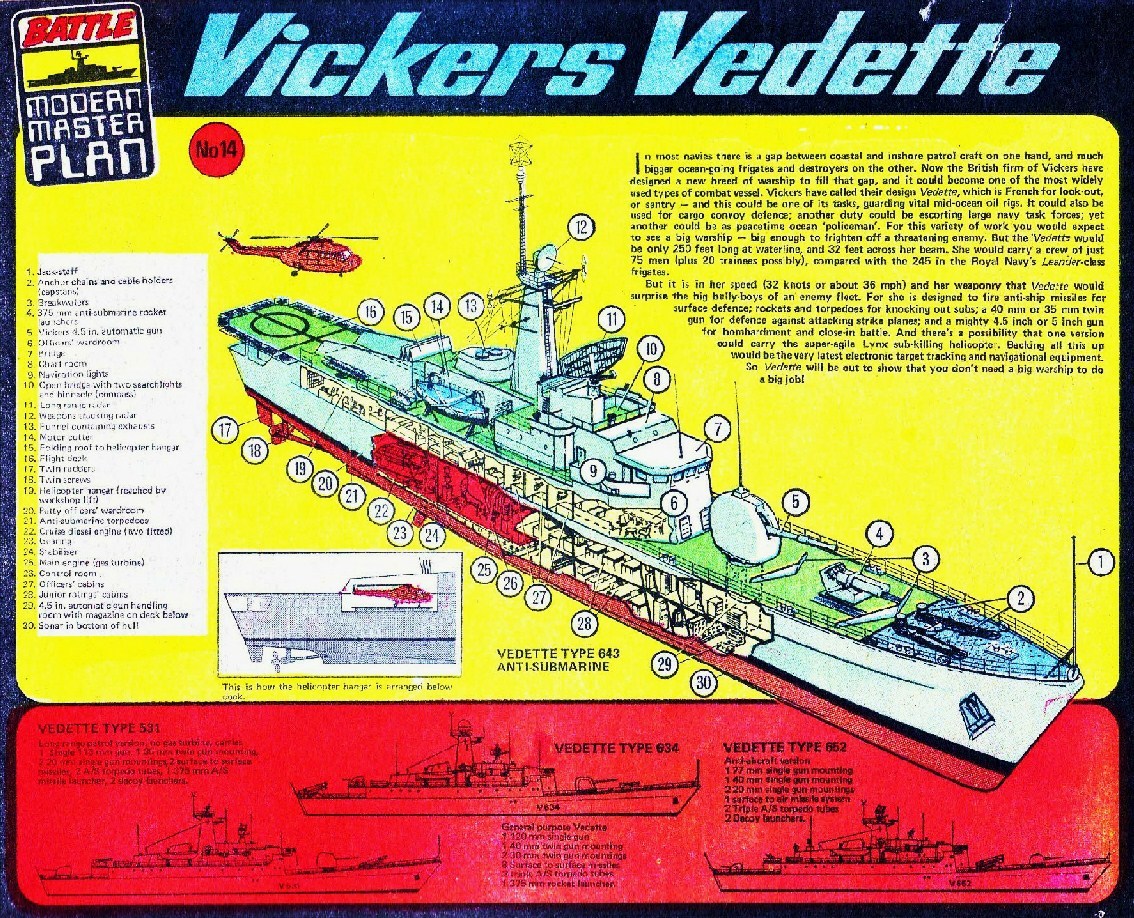 1 - флагшток;
2 - якорные цепи и шпили;
3 - волноломы;
4 - 375 мм п/л ракетная установка;
5 - 4.5" автоматическая пушка главного калибра;
6 - офицерская каюткомпания;
7 - ходовая рубка;
8 - боевая рубка;
9 - навигационный (правый отличительный) огонь;
10 - открытый (верхний) мостик с двумя легкими пушками;
11 - РЛС кругового обзора (дальнего обноружения);
12 - РЛС управления артустановкой главного калибра;
13 - дымовая труба;
14 - моторный катер;
15 - сдвижная крыша вертолетного ангара;
16 - посадочная палуба (вертолета);
17 - руль;
18 - винт;
19 - вертолетный ангар (с подъемником);
20 - каюткомпания (общая);
21 - п/л торпедный аппарат;
22 - машинное отделение с 2-я дизелями;
23 - баки;
24 - стабилизатор;
25 - главный двигатель (газовая турбина);
26 - пост управления;
27 - офицерские каюты;
28 - курсантские каюты;
29 - подпалубный магазин боекомплекта 4.5" пушки;
30 - подкильная гидроакустическая станция.
1 - флагшток;
2 - якорные цепи и шпили;
3 - волноломы;
4 - 375 мм п/л ракетная установка;
5 - 4.5" автоматическая пушка главного калибра;
6 - офицерская каюткомпания;
7 - ходовая рубка;
8 - боевая рубка;
9 - навигационный (правый отличительный) огонь;
10 - открытый (верхний) мостик с двумя легкими пушками;
11 - РЛС кругового обзора (дальнего обноружения);
12 - РЛС управления артустановкой главного калибра;
13 - дымовая труба;
14 - моторный катер;
15 - сдвижная крыша вертолетного ангара;
16 - посадочная палуба (вертолета);
17 - руль;
18 - винт;
19 - вертолетный ангар (с подъемником);
20 - каюткомпания (общая);
21 - п/л торпедный аппарат;
22 - машинное отделение с 2-я дизелями;
23 - баки;
24 - стабилизатор;
25 - главный двигатель (газовая турбина);
26 - пост управления;
27 - офицерские каюты;
28 - курсантские каюты;
29 - подпалубный магазин боекомплекта 4.5" пушки;
30 - подкильная гидроакустическая станция.
Хранение вертолета на нижней палубе ангара.
AUSTRALIA TYPE 633 AND TYPE 642 PROJECTS
After the cancellation of the DDL, the government instructed the
RAN to examine a range of existing designs to identify those that might
be suitable as the RAN's new destroyer. The range of options was
wide, and based on the involvement with Vickers Barrow in the 1974
Vickers Vedette proposal for Indonesia, Cockatoo, with guidance from
Barrow, developed 'Australianised' versions of the Vedette which
became known as Type 633 and 642.
The work mainly involved altering the Vedette design to incorporate
US weapons and other RAN specific requirements. The Vickers
Vedette was a private venture design for a small simple and inexpensive
patrol corvette, with excellent sea keeping ability and low 'through life'
cost. The designed displacement was around 1200 tons on a waterline
length of 72 metres and a beam of 10 metres. Propulsion machinery
comprised two diesel engines for cruising and one gas turbine for high
speed, driving two shafts. Maximum speed was to be about 34 knots.
The Vedette Type 633 was armed with one 5-inch gun, two 35-millimetre
Oerlikon guns in a twin mounting, two triple Mark 32 torpedo
tubes, and eight Harpoon surface-to-surface missiles. In the Type 642,
the secondary armament was reduced and a helicopter and hangar fitted.
The Vedette was considered too small to satisfy the RAN's needs,
and suffered because it was not a 'proven' design, however good its
design origins. The work on the design did, however, provide interest
for the Cackatoo technical people at a time when there was little alternative
work on the horizon. The RAN finally selected the US Navy
guided missile frigate (FFG 7) design, which had a similar armament to
the DDL. Two ships, which became HMAS Adelaide and HMAS
Canberra, were ordered from the Unated States in August 1974.








|
Источники: Vickers Vedette. / ж. 'Model Boats', December 1975. 632-635 p.
Cockatoo Island: Sydney's Historic Dockyard By John Jeremy
www.shipbucket.com
Scan: ??? Edit & OCR: MasterRU
| |
| © ReSim Laboratory 2004-2022 |
|